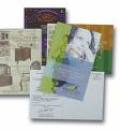
Post Cards Reviews
|
HISTORY OF POSTCARDS...EARLY ERA
History Of Postcards... Early Era
PIONEER ERA ( 1889 - 1898 )
This era began when vendors and exhibitors at the French Exposition in France ( 1889 ) started selling picture postcards. They gained much popularity and helped keep postcards in circulation. They are scarce today and have combinations of the following distinctions:
Undivided backs ( no line dividing address and message ) Does not say " Authorized by Act of Congress " in byline. If American, they have a Grant or Jefferson head stamp, most are multiple view cards postage rate, if listed, will be 2 cents. It is usually called Mail Card or Souvenir Card mostly used in larger Eastern cities /
PRIVATE MAILING CARD ERA ( 1898 - 1901 )
As of May 19, 1898, government gave private printers permission to both sell and print postcards inscribed with the words " Private Mailing Card. " ( Abbreviated today as PMCs ). Many Pioneer Era cards were reprinted as PMCs. Postcards of this era have undivided backs as well. You were still not able to write on the back of the Post Card forcing people to write on the front. During this period around 1900, Real Photo postcards ( RPs, postcards on film stock: i. e. pictures ) began to come into use. These early real photo images were mainly advertisements.
In 1898 postage required for mailing a postcard was reduced from 2 cents to 1 cent.
UNDIVIDED BACK ERA ( 1901 - 1907 )
As of December 24, 1901, printers were allowed to use " Post Card " on the backs of their cards. All of these cards had undivided backs ( Writing was still not permitted on the address side ). For Undivided Back Era postcards, writing on the front is acceptable, not usually decreasing the condition grade of these cards but there are exceptions to every rule. The publishing of printed postcards during this time doubled almost every six months! In addition, European publishers opened offices in the U. S. and imported millions of high - quality postcards. By 1907, European publishers accounted for over 75 % of all postcards sold in the U. S. The popularity of lithographed cards caught Eastman - Kodak's attention as well. His company issued an affordable " Folding Pocket Kodak " camera around 1906. This enabled the mass public to take black & white photographs and have them printed directly onto paper with postcard backs. Various other models of
Kodak " postcard " cameras followed resulting in an explosion in the real photo postcard era. These cameras shared two unique features: their negatives were postcard size ( the major reason why so many of these images are so clear ) and they had a small thin door at the back that, when lifted, enabled the photographer to write an identifying caption or comment on the negative itself with an attached metal scribe. Also interesting to note is at the end of this period in time, the picture postcard hobby became the greatest collectible hobby that the world has ever known and still today is one of the most desired collectibles. The official figures from the U. S. Post Office for the fiscal year ending June 30, 1908, cite 677, 777, 798 postcards were mailed. That was at a time when the total population of the U. S. was 88, 700, 000. That is an amazing piece of American trivia!
About The Author:
Peter Dobler is a veteran in the IT business. His passion for experimenting with new internet marketing strategies leads him to explore new niche markets.
Read more about his experience with post cards; visit http://post-cards.tip4u2.com
 |
 |
 |
POSTCARDS THAT ARE WORTH A PRETTY PENNY
THE HISTORY OF EASTER POSTCARDS
More Post Cards Articles
... similarly whimsical attachment of every kind were applied. The list includes die - cuts of flowers, horseshoes, doves and little notes in tiny envelopes. A number of " magic light " varieties such as hold - to lights and transparencies enjoyed brisk sales. Quite often, especially after 1910, many publishers ...
... names. The most noticeable change in postcards since the beginning of the chrome era has been their size: - " Standard. " For almost a century the standard size for a postcard was 5 1 / 2 inches by 3 1 / 2 inches. The first postal cards issued by the Post Office were roughly the same size as a standard ...
THE HISTORY OF EASTER POSTCARDS
... Young girls were a symbol for luck and hope. The Easter bunny which was a personified symbol of fruitfulness was often portrayed with eggs. German publishers were leading in the production of Easter postcards before the first world war. During the time of the first world war the children were replaced ...
... now highly sought after and rare examples can command very high prices at auction. The best known saucy seaside postcards were created by a publishing company called Bamforths, based in the town of Holmfirth, West Yorkshire, England. Despite the decline in popularity of postcards that are overtly saucy, ...

|
| Copyright © 2006-2012 Internet Marketing Tools, All Rights Reserved |